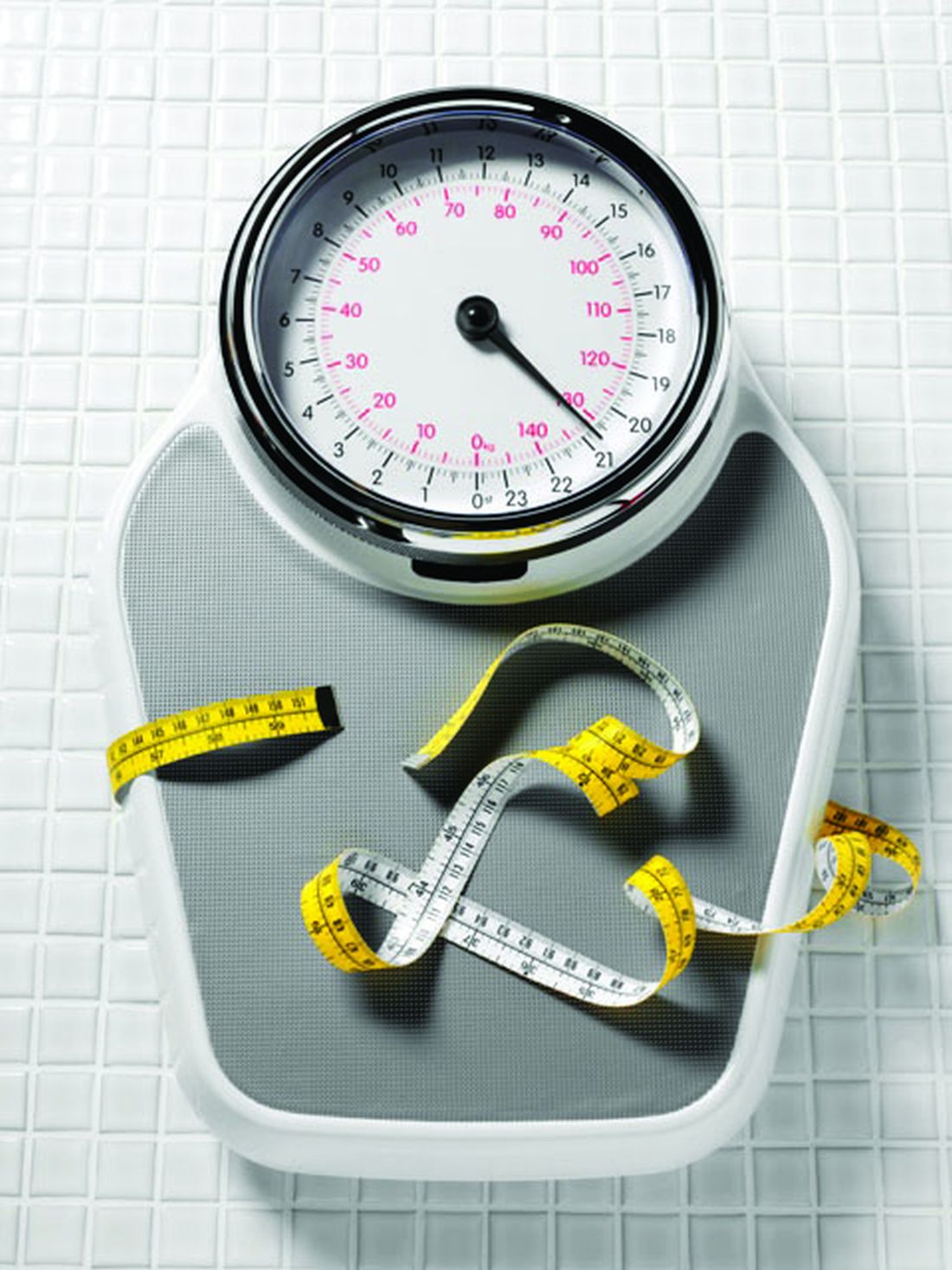User login
Losing weight and lowering body mass index may help people slow, delay, or even prevent the structural defects of knee osteoarthritis, especially on the medial side of the knee, results of a prospective multicohort study from Australia suggest.
“We showed that the more weight that is lost, the greater the apparent benefit for delaying or preventing knee joint degradation in osteoarthritis,” senior study author Amanda Sainsbury, PhD, professor of obesity research at the University of Western Australia, Perth, said in an interview. “For example, a person weighing 100 kilograms [220 pounds] who loses 10 kilograms [22 pounds] is likely to have double the benefit compared to losing 5 kilograms [11 pounds].”
“We showed evidence of association, not causality,” she and her colleagues wrote in Arthritis & Rheumatology. “Future randomized, controlled trials are required to demonstrate causality.”
Dr. Sainsbury and colleagues analyzed radiographs of knees from three independent cohort studies from the United States and the Netherlands – the Osteoarthritis Initiative (OAI), the Multicenter Osteoarthritis Study (MOST), and the Cohort Hip and Cohort Knee (CHECK) study – at baseline and again 4-5 years later.
The authors created two groups of knees at baseline: the “incidence cohort” of 9,683 knees from 5,774 participants without OA structural defects (Kellgren-Lawrence grade 0 or 1) and the “progression cohort” of 6,075 knees from 3,988 participants with OA structural defects (KL grade 2 or higher). After 4-5 years, they determined OA incidence (KL grade 2 or higher in participants without baseline knee OA) and progression (increase of one or more KL grades in those with baseline knee OA).At baseline, the mean patient age in both groups was around 60, and around 60% of participants were female. In the incidence and progression groups, respectively, White patients comprised 87.5% and 80.4% of participants; mean body mass index was 28.2 and 30.4 kg/m2; and 32.6% and 48.4% of participants were obese (BMI, 30 or higher). The authors combined data from the three studies and used logistic regression and generalized estimating equations, with clustering of both knees within individuals. On multivariable analysis, they found that change in BMI 4-5 years post baseline was positively linked with both incidence and progression of knee OA structural defects.
In the incidence group, BMI decreased 1 or more units in 1,101 patients and increased 1 or more units in 1,611. In the progression group, BMI decreased 1 or more units in 798 patients and increased in 1,008.
The adjusted odds ratio for overall structural defects in the incidence group was 1.05 (95% confidence interval, 1.02-1.09) and 1.05 (95% CI, 1.01-1.09) in the progression group was. A 1-unit decrease in BMI was linked with a nearly 5% drop in odds of incidence and progression of knee OA, and a 5-unit decrease was linked with a more than 21% drop in odds of incidence and progression.
In the incidence group, change in BMI was positively linked with medial, but not lateral, joint space degeneration (narrowing; OR, 1.08; 95% CI, 1.04-1.12) and with medial femoral surface degeneration indicated by osteophytes (OR, 1.07; 95% CI, 1.03-1.12).
In the progression group, change in BMI was positively linked with overall structural defects (OR, 1.05; 95% CI, 1.01-1.09) as well as medial, but not lateral, joint space degeneration (OR, 1.08; 95% CI, 1.03-1.12).
“Previous research showed that weight loss helps reduce symptoms of knee osteoarthritis, such as pain and impaired physical function,” said lead study author Zübeyir Salis, BEng, a PhD student in public health at the University of New South Wales, Kensington, Australia. “Weight loss is emerging as a suitable strategy for potentially delaying and preventing osteoarthritic knee joint degeneration.”
Two experts not involved in the study welcome its results
Kai Sun, MD, MS, assistant professor of medicine, rheumatology, and immunology at Duke University, Durham, N. C., said it makes mechanical sense that less weight bearing decreases knee damage over time, but she was somewhat surprised that even people who started with normal BMI improved their outcomes by decreasing BMI further.
“Knee osteoarthritis and obesity prevalence are both growing,” Dr. Sun said. “Knee osteoarthritis may one day be considered an obesity-related comorbidity like hypertension and diabetes and be used as additional justification for pharmacologic or nonpharmacologic interventions to treat obesity.”
She noted that the study’s major strengths include its large sample size, long follow-up, and separate inclusion of disease incidence and progression, but also noted some limitations.
“BMI data at only two time points does not consider BMI fluctuations between those times,” she added. “Limited data were presented on physical activity levels, and most participants being White and elderly limited the generalizability of the results.”
Eduardo Grunvald, MD, professor of medicine and medical director of the weight management program at the University of California, San Diego, agreed about the study’s strengths and pointed out its lack of information about the cause of BMI changes.
Dr. Grunvald would like to know whether the BMI changes contributed to the knee changes or vice versa. “An individual’s worsening knee pain could lead to less physical activity and possible increased BMI.
“Long-term weight-loss maintenance is extremely challenging, and for optimal outcomes, medical professionals who treat joint disease should partner with clinicians trained to treat obesity,” he advised.
The authors are planning further related research. “We’re looking forward to running a randomized, controlled clinical weight-loss trial,” Dr. Sainsbury said.The study was supported by scholarship and fellowship funds from the Australian government. Mr. Salis and Dr. Sainsbury each own 50% of shares in a company that provides educational resources and services in adult weight management. Dr. Sainsbury and one coauthor reported relevant financial relationships with various pharmaceutical companies. Dr. Sun and Dr. Grunvald reported no relevant financial relationships.
Losing weight and lowering body mass index may help people slow, delay, or even prevent the structural defects of knee osteoarthritis, especially on the medial side of the knee, results of a prospective multicohort study from Australia suggest.
“We showed that the more weight that is lost, the greater the apparent benefit for delaying or preventing knee joint degradation in osteoarthritis,” senior study author Amanda Sainsbury, PhD, professor of obesity research at the University of Western Australia, Perth, said in an interview. “For example, a person weighing 100 kilograms [220 pounds] who loses 10 kilograms [22 pounds] is likely to have double the benefit compared to losing 5 kilograms [11 pounds].”
“We showed evidence of association, not causality,” she and her colleagues wrote in Arthritis & Rheumatology. “Future randomized, controlled trials are required to demonstrate causality.”
Dr. Sainsbury and colleagues analyzed radiographs of knees from three independent cohort studies from the United States and the Netherlands – the Osteoarthritis Initiative (OAI), the Multicenter Osteoarthritis Study (MOST), and the Cohort Hip and Cohort Knee (CHECK) study – at baseline and again 4-5 years later.
The authors created two groups of knees at baseline: the “incidence cohort” of 9,683 knees from 5,774 participants without OA structural defects (Kellgren-Lawrence grade 0 or 1) and the “progression cohort” of 6,075 knees from 3,988 participants with OA structural defects (KL grade 2 or higher). After 4-5 years, they determined OA incidence (KL grade 2 or higher in participants without baseline knee OA) and progression (increase of one or more KL grades in those with baseline knee OA).At baseline, the mean patient age in both groups was around 60, and around 60% of participants were female. In the incidence and progression groups, respectively, White patients comprised 87.5% and 80.4% of participants; mean body mass index was 28.2 and 30.4 kg/m2; and 32.6% and 48.4% of participants were obese (BMI, 30 or higher). The authors combined data from the three studies and used logistic regression and generalized estimating equations, with clustering of both knees within individuals. On multivariable analysis, they found that change in BMI 4-5 years post baseline was positively linked with both incidence and progression of knee OA structural defects.
In the incidence group, BMI decreased 1 or more units in 1,101 patients and increased 1 or more units in 1,611. In the progression group, BMI decreased 1 or more units in 798 patients and increased in 1,008.
The adjusted odds ratio for overall structural defects in the incidence group was 1.05 (95% confidence interval, 1.02-1.09) and 1.05 (95% CI, 1.01-1.09) in the progression group was. A 1-unit decrease in BMI was linked with a nearly 5% drop in odds of incidence and progression of knee OA, and a 5-unit decrease was linked with a more than 21% drop in odds of incidence and progression.
In the incidence group, change in BMI was positively linked with medial, but not lateral, joint space degeneration (narrowing; OR, 1.08; 95% CI, 1.04-1.12) and with medial femoral surface degeneration indicated by osteophytes (OR, 1.07; 95% CI, 1.03-1.12).
In the progression group, change in BMI was positively linked with overall structural defects (OR, 1.05; 95% CI, 1.01-1.09) as well as medial, but not lateral, joint space degeneration (OR, 1.08; 95% CI, 1.03-1.12).
“Previous research showed that weight loss helps reduce symptoms of knee osteoarthritis, such as pain and impaired physical function,” said lead study author Zübeyir Salis, BEng, a PhD student in public health at the University of New South Wales, Kensington, Australia. “Weight loss is emerging as a suitable strategy for potentially delaying and preventing osteoarthritic knee joint degeneration.”
Two experts not involved in the study welcome its results
Kai Sun, MD, MS, assistant professor of medicine, rheumatology, and immunology at Duke University, Durham, N. C., said it makes mechanical sense that less weight bearing decreases knee damage over time, but she was somewhat surprised that even people who started with normal BMI improved their outcomes by decreasing BMI further.
“Knee osteoarthritis and obesity prevalence are both growing,” Dr. Sun said. “Knee osteoarthritis may one day be considered an obesity-related comorbidity like hypertension and diabetes and be used as additional justification for pharmacologic or nonpharmacologic interventions to treat obesity.”
She noted that the study’s major strengths include its large sample size, long follow-up, and separate inclusion of disease incidence and progression, but also noted some limitations.
“BMI data at only two time points does not consider BMI fluctuations between those times,” she added. “Limited data were presented on physical activity levels, and most participants being White and elderly limited the generalizability of the results.”
Eduardo Grunvald, MD, professor of medicine and medical director of the weight management program at the University of California, San Diego, agreed about the study’s strengths and pointed out its lack of information about the cause of BMI changes.
Dr. Grunvald would like to know whether the BMI changes contributed to the knee changes or vice versa. “An individual’s worsening knee pain could lead to less physical activity and possible increased BMI.
“Long-term weight-loss maintenance is extremely challenging, and for optimal outcomes, medical professionals who treat joint disease should partner with clinicians trained to treat obesity,” he advised.
The authors are planning further related research. “We’re looking forward to running a randomized, controlled clinical weight-loss trial,” Dr. Sainsbury said.The study was supported by scholarship and fellowship funds from the Australian government. Mr. Salis and Dr. Sainsbury each own 50% of shares in a company that provides educational resources and services in adult weight management. Dr. Sainsbury and one coauthor reported relevant financial relationships with various pharmaceutical companies. Dr. Sun and Dr. Grunvald reported no relevant financial relationships.
Losing weight and lowering body mass index may help people slow, delay, or even prevent the structural defects of knee osteoarthritis, especially on the medial side of the knee, results of a prospective multicohort study from Australia suggest.
“We showed that the more weight that is lost, the greater the apparent benefit for delaying or preventing knee joint degradation in osteoarthritis,” senior study author Amanda Sainsbury, PhD, professor of obesity research at the University of Western Australia, Perth, said in an interview. “For example, a person weighing 100 kilograms [220 pounds] who loses 10 kilograms [22 pounds] is likely to have double the benefit compared to losing 5 kilograms [11 pounds].”
“We showed evidence of association, not causality,” she and her colleagues wrote in Arthritis & Rheumatology. “Future randomized, controlled trials are required to demonstrate causality.”
Dr. Sainsbury and colleagues analyzed radiographs of knees from three independent cohort studies from the United States and the Netherlands – the Osteoarthritis Initiative (OAI), the Multicenter Osteoarthritis Study (MOST), and the Cohort Hip and Cohort Knee (CHECK) study – at baseline and again 4-5 years later.
The authors created two groups of knees at baseline: the “incidence cohort” of 9,683 knees from 5,774 participants without OA structural defects (Kellgren-Lawrence grade 0 or 1) and the “progression cohort” of 6,075 knees from 3,988 participants with OA structural defects (KL grade 2 or higher). After 4-5 years, they determined OA incidence (KL grade 2 or higher in participants without baseline knee OA) and progression (increase of one or more KL grades in those with baseline knee OA).At baseline, the mean patient age in both groups was around 60, and around 60% of participants were female. In the incidence and progression groups, respectively, White patients comprised 87.5% and 80.4% of participants; mean body mass index was 28.2 and 30.4 kg/m2; and 32.6% and 48.4% of participants were obese (BMI, 30 or higher). The authors combined data from the three studies and used logistic regression and generalized estimating equations, with clustering of both knees within individuals. On multivariable analysis, they found that change in BMI 4-5 years post baseline was positively linked with both incidence and progression of knee OA structural defects.
In the incidence group, BMI decreased 1 or more units in 1,101 patients and increased 1 or more units in 1,611. In the progression group, BMI decreased 1 or more units in 798 patients and increased in 1,008.
The adjusted odds ratio for overall structural defects in the incidence group was 1.05 (95% confidence interval, 1.02-1.09) and 1.05 (95% CI, 1.01-1.09) in the progression group was. A 1-unit decrease in BMI was linked with a nearly 5% drop in odds of incidence and progression of knee OA, and a 5-unit decrease was linked with a more than 21% drop in odds of incidence and progression.
In the incidence group, change in BMI was positively linked with medial, but not lateral, joint space degeneration (narrowing; OR, 1.08; 95% CI, 1.04-1.12) and with medial femoral surface degeneration indicated by osteophytes (OR, 1.07; 95% CI, 1.03-1.12).
In the progression group, change in BMI was positively linked with overall structural defects (OR, 1.05; 95% CI, 1.01-1.09) as well as medial, but not lateral, joint space degeneration (OR, 1.08; 95% CI, 1.03-1.12).
“Previous research showed that weight loss helps reduce symptoms of knee osteoarthritis, such as pain and impaired physical function,” said lead study author Zübeyir Salis, BEng, a PhD student in public health at the University of New South Wales, Kensington, Australia. “Weight loss is emerging as a suitable strategy for potentially delaying and preventing osteoarthritic knee joint degeneration.”
Two experts not involved in the study welcome its results
Kai Sun, MD, MS, assistant professor of medicine, rheumatology, and immunology at Duke University, Durham, N. C., said it makes mechanical sense that less weight bearing decreases knee damage over time, but she was somewhat surprised that even people who started with normal BMI improved their outcomes by decreasing BMI further.
“Knee osteoarthritis and obesity prevalence are both growing,” Dr. Sun said. “Knee osteoarthritis may one day be considered an obesity-related comorbidity like hypertension and diabetes and be used as additional justification for pharmacologic or nonpharmacologic interventions to treat obesity.”
She noted that the study’s major strengths include its large sample size, long follow-up, and separate inclusion of disease incidence and progression, but also noted some limitations.
“BMI data at only two time points does not consider BMI fluctuations between those times,” she added. “Limited data were presented on physical activity levels, and most participants being White and elderly limited the generalizability of the results.”
Eduardo Grunvald, MD, professor of medicine and medical director of the weight management program at the University of California, San Diego, agreed about the study’s strengths and pointed out its lack of information about the cause of BMI changes.
Dr. Grunvald would like to know whether the BMI changes contributed to the knee changes or vice versa. “An individual’s worsening knee pain could lead to less physical activity and possible increased BMI.
“Long-term weight-loss maintenance is extremely challenging, and for optimal outcomes, medical professionals who treat joint disease should partner with clinicians trained to treat obesity,” he advised.
The authors are planning further related research. “We’re looking forward to running a randomized, controlled clinical weight-loss trial,” Dr. Sainsbury said.The study was supported by scholarship and fellowship funds from the Australian government. Mr. Salis and Dr. Sainsbury each own 50% of shares in a company that provides educational resources and services in adult weight management. Dr. Sainsbury and one coauthor reported relevant financial relationships with various pharmaceutical companies. Dr. Sun and Dr. Grunvald reported no relevant financial relationships.
FROM ARTHRITIS & RHEUMATOLOGY




